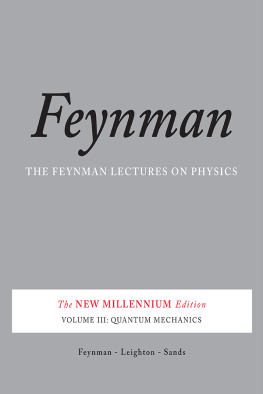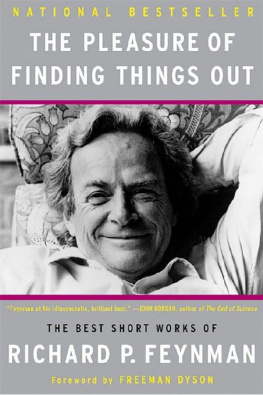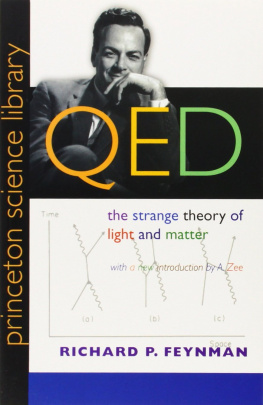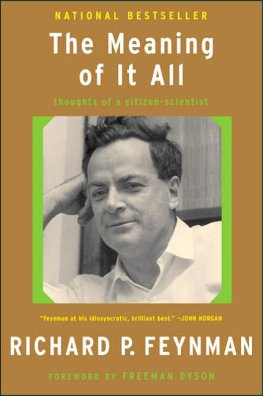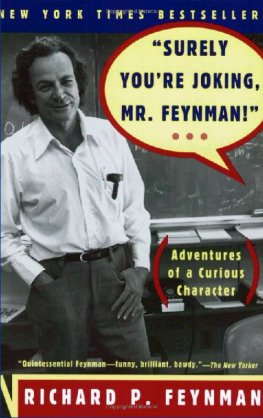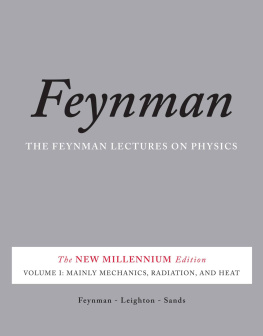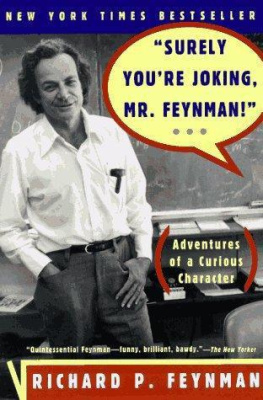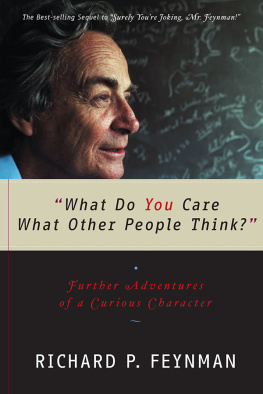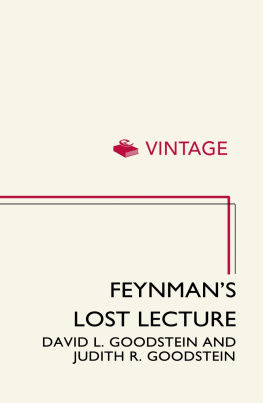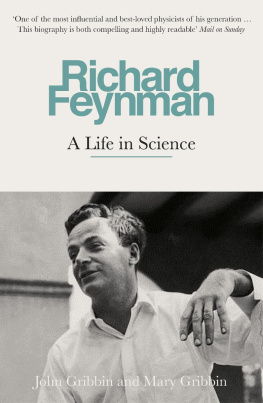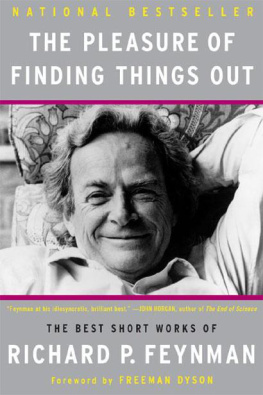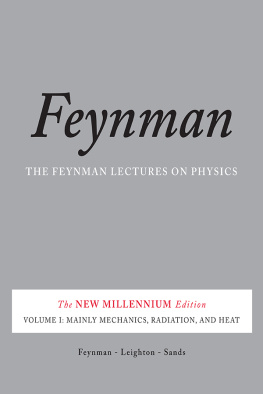A chain reaction is not a bad analogy for Feynmans life. From a critical mass of gray matter it goes off in all directions, producing both heat and light.
Feynman is legendary among his colleagues for his brilliance and his eccentricity. Its hard not to smile all the way through.
Hilarious, exhilarating. Feynmans language is vivid, lively, and unpretentious. A refreshing message, indeed.
If you are one of these people who think there cant be much fun in physicsor physicistsmeet Mr. Feynman. One of the funniest fellows who ever juggled a bunch of atoms.
If a single book can shatter the stereotype of the stuffy scientist, this may be the one.
Surely Youre Joking, Mr. Feynman!
Adventures of a Curious Character
Richard P. Feynman
as told to Ralph Leighton
edited by Edward Hutchings
W. W. Norton & Company
New York London
Copyright 1985 by Richard P. Feynman and Ralph Leighton. All rights reserved .
First published as a Norton 1997
Library of Congress Cataloging in Publication Data
Feynman, Richard Phillips.
Surely youre joking, Mr. Feynman!
1. Feynman, Richard Phillips. 2. PhysicistsUnited StatesBiography. 3. ScienceAnecdotes, facetiae, satire, etc. I. Leighton, Ralph. II. Hutchings, Edward. III. Title.
QC16.F49A37 1985 530'092'4 [B] 84-14703
ISBN: 978-0-393-31604-9
W. W. Norton & Company, Inc.
500 Fifth Avenue, New York, N.Y. 10110
www.wwnorton.com
W. W. Norton & Company Ltd.
Castle House, 75/76 Wells Street, London WIT 3QT
Preface
THE STORIES in this book were collected intermittently and informally during seven years of very enjoyable drumming with Richard Feynman. I have found each story by itself to be amusing, and the collection taken together to be amazing: That one person could have so many wonderfully crazy things happen to him in one life is sometimes hard to believe. That one person could invent so much innocent mischief in one life is surely an inspiration!
R ALPH L EIGHTON
Note to the Norton Edition
The continuing interest in Richard Feynman more than ten years after the publication of Surely Youre Joking, Mr. Feynman! reminds me of a phrase oft spoken by him, with a twinkle in his eye, as he approached the end of his life: I aint dead yet!
RL
Contents
Introduction
I HOPE these wont be the only memoirs of Richard Feynman. Certainly the reminiscences here give a true picture of much of his characterhis almost compulsive need to solve puzzles, his provocative mischievousness, his indignant impatience with pretension and hypocrisy, and his talent for one-upping anybody who tries to one-up him! This book is great reading: outrageous, shocking, still warm and very human.
For all that, it only skirts the keystone of his life: science. We see it here and there, as background material in one sketch or another, but never as the focus of his existence, which generations of his students and colleagues know it to be. Perhaps nothing else is possible. There may be no way to construct such a series of delightful stories about himself and his work: the challenge and frustration, the excitement that caps insight, the deep pleasure of scientific understanding that has been the wellspring of happiness in his life.
I remember when I was his student how it was when you walked into one of his lectures. He would be standing in front of the hall smiling at us all as we came in, his fingers tapping out a complicated rhythm on the black top of the demonstration bench that crossed the front of the lecture hall. As latecomers took their seats, he picked up the chalk and began spinning it rapidly through his fingers in a manner of a professional gambler playing with a poker chip, still smiling happily as if at some secret joke. And thenstill smilinghe talked to us about physics, his diagrams and equations helping us to share his understanding. It was no secret joke that brought the smile and the sparkle in his eye, it was physics. The joy of physics! The joy was contagious. We are fortunate who caught that infection. Now here is your opportunity to be exposed to the joy of life in the style of Feynman.
A LBERT R. H IBBS
Senior Member of the Technical Staff ,
Jet Propulsion Laboratory,
California Institute of Technology
Vitals
SOME FACTS about my timing: I was born in 1918 in a small town called Far Rockaway, right on the outskirts of New York, near the sea. I lived there until 1935, when I was seventeen. I went to MIT for four years, and then I went to Princeton, in about 1939. During the time I was at Princeton I started to work on the Manhattan Project, and I ultimately went to Los Alamos in April 1943, until something like October or November 1946, when I went to Cornell.
I got married to Arlene in 1941, and she died of tuberculosis while I was at Los Alamos, in 1946.
I was at Cornell until about 1951. I visited Brazil in the summer of 1949 and spent half a year there in 1951, and then went to Caltech, where Ive been ever since.
I went to Japan at the end of 1951 for a couple of weeks, and then again, a year or two later, just after I married my second wife, Mary Lou.
I am now married to Gweneth, who is English, and we have two children, Carl and Michelle.
R. P. F.
Surely Youre Joking, Mr. Feynman!
Part
FROM FAR ROCKAWAY TO MIT
He Fixes Radios by Thinking!
WHEN I WAS about eleven or twelve I set up a lab in my house. It consisted of an old wooden packing box that I put shelves in. I had a heater, and Id put in fat and cook french-fried potatoes all the time. I also had a storage battery, and a lamp bank.
To build the lamp bank I went down to the five-and-ten and got some sockets you can screw down to a wooden base, and connected them with pieces of bell wire. By making different combinations of switchesin series or parallelI knew I could get different voltages. But what I hadnt realized was that a bulbs resistance depends on its temperature, so the results of my calculations werent the same as the stuff that came out of the circuit. But it was all right, and when the bulbs were in series, all half-lit, they would gloooooooooow , very prettyit was great!
I had a fuse in the system so if I shorted anything, the fuse would blow. Now I had to have a fuse that was weaker than the fuse in the house, so I made my own fuses by taking tin foil and wrapping it around an old burnt-out fuse. Across my fuse I had a five-watt bulb, so when my fuse blew, the load from the trickle charger that was always charging the storage battery would light up the bulb. The bulb was on the switchboard behind a piece of brown candy paper (it looks red when a lights behind it)so if something went off, Id look up to the switchboard and there would be a big red spot where the fuse went. It was fun!
I enjoyed radios. I started with a crystal set that I bought at the store, and I used to listen to it at night in bed while I was going to sleep, through a pair of earphones. When my mother and father went out until late at night, they would come into my room and take the earphones offand worry about what was going into my head while I was asleep.
About that time I invented a burglar alarm, which was a very simple-minded thing: it was just a big battery and a bell connected with some wire. When the door to my room opened, it pushed the wire against the battery and closed the circuit, and the bell would go off.


